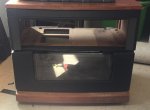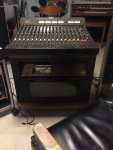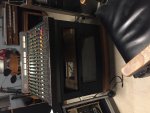The mixer you have can be made to work.
For me though, this is my preferred set up with any rack mount cassette.
Get twice the mixer channels than you have tape tracks.
For a 4 track, 8. For an 8 track 16.
With this setup you can have channels 1 thru 4 set up for tracking. Channels 5 thru 8 are for monitoring what's already been recorded.
Come mixdown time, your tracking channels (1 thru 4) can now be used for effects returns, additional sources such as audio from a midi source, etc.
Personally, I'd prefer a 16 channel mixer. There are bunches of good affordable ones that will fit in a standard 19 inch rack space.
Besides, should you want to go 8 track, you're already set up.
Anyway, I'll shut up. I've already caused you enough trouble.









